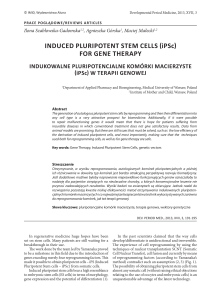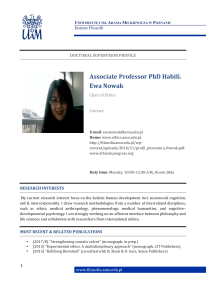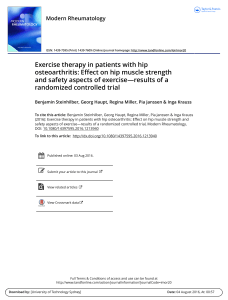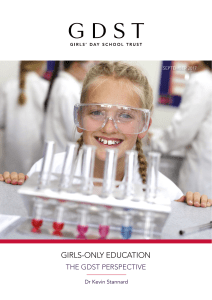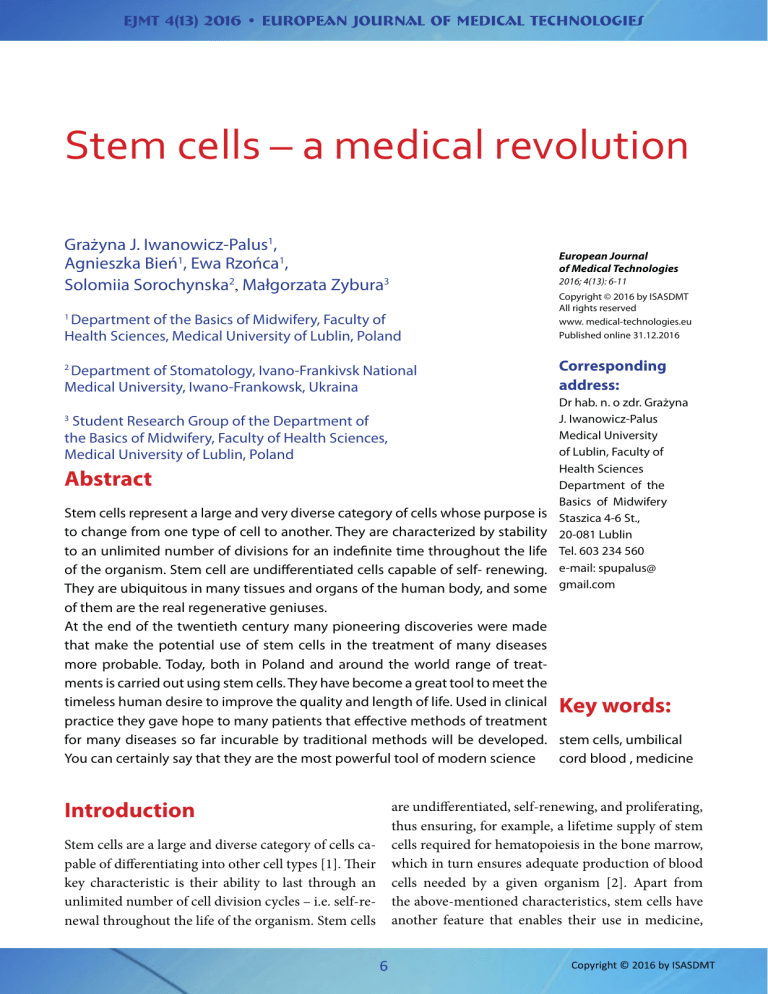
EJMT 4(13) 2016 • European Journal of Medical Technologies
Stem cells – a medical revolution
Grażyna J. Iwanowicz-Palus1,
Agnieszka Bień1, Ewa Rzońca1,
Solomiia Sorochynska2, Małgorzata Zybura3
European Journal
of Medical Technologies
2016; 4(13): 6-11
1
Department of the Basics of Midwifery, Faculty of
Health Sciences, Medical University of Lublin, Poland
Copyright © 2016 by ISASDMT
All rights reserved
www. medical-technologies.eu
Published online 31.12.2016
Department of Stomatology, Ivano-Frankivsk National
Medical University, Iwano-Frankowsk, Ukraina
Corresponding
­address:
2
Student Research Group of the Department of
the Basics of Midwifery, Faculty of Health Sciences,
Medical University of Lublin, Poland
3
Abstract
Dr hab. n. o zdr. Grażyna
J. Iwanowicz-Palus
Medical University
of Lublin, Faculty of
Health Sciences
Department of the
Basics of Midwifery
Staszica 4-6 St.,
20-081 Lublin
Tel. 603 234 560
e-mail: spupalus@
gmail.com
Stem cells represent a large and very diverse category of cells whose purpose is
to change from one type of cell to another. They are characterized by stability
to an unlimited number of divisions for an indefinite time throughout the life
of the organism. Stem cell are undifferentiated cells capable of self- renewing.
They are ubiquitous in many tissues and organs of the human body, and some
of them are the real regenerative geniuses.
At the end of the twentieth century many pioneering discoveries were made
that make the potential use of stem cells in the treatment of many diseases
more probable. Today, both in Poland and around the world range of treatments is carried out using stem cells. They have become a great tool to meet the
timeless human desire to improve the quality and length of life. Used in clinical Key words:
practice they gave hope to many patients that effective methods of treatment
for many diseases so far incurable by traditional methods will be developed. stem cells, umbilical
You can certainly say that they are the most powerful tool of modern science
cord blood , medicine
Introduction
are undifferentiated, self-renewing, and proliferating,
thus ensuring, for example, a lifetime supply of stem
cells required for hematopoiesis in the bone marrow,
which in turn ensures adequate production of blood
cells needed by a given organism [2]. Apart from
the above-mentioned characteristics, stem cells have
another feature that enables their use in medicine,
Stem cells are a large and diverse category of cells capable of differentiating into other cell types [1]. Their
key characteristic is their ability to last through an
unlimited number of cell division cycles – i.e. self-renewal throughout the life of the organism. Stem cells
6
Copyright © 2016 by ISASDMT
EJMT 4(13) 2016 • European Journal of Medical Technologies
which is their capability of developing into various
specialized daughter cells required to compensate for
losses due to the aging of mature cells [3]. Stem cells
are present in many human tissues, enabling their repair in case of damage or wear. Another characteristic of stem cells is plasticity, meaning the ability to
differentiate into cells of a germ layer other than the
one they originate from – i.e. changing their lineage,
together with their physical and functional characteristics. This process is called transdifferentiation
and occurs e.g. in blood stem cells that transform
into liver cells [2].
In humans, stem cells reside in a multitude of locations [4], including the placenta and umbilical cord;
peripheral blood; dermis; olfactory bulbs – the pair
of Q-shaped organs located behind the eyes. Stem
cell activity has been found in bones, in muscular
connective tissue, at the intestinal wall. Large quantities of stem cells are present in the brain, heart, lungs,
pancreas, thymus, spleen, liver, and kidneys. Bone
marrow is a niche for stem cells, and more precisely,
for one of their most common types – hematopoietic
stem cells [2,5].
Stem cells reside in most human organs, and some
types have exceptional regenerative capabilities.
Based on their origin, stem cells can be identified as
embryonic SCs, fetal SCs, cord blood SCs, and somatic SCs [2].
Stem cells are considered highly heterogeneous in
terms of potency. In descending order, they can be
classified as:
1. Totipotent – unique cells with the broadest capabilities for development. A fertilized ovum,
i.e. a zygote, is an example. Totipotency entails
the capability of forming a new independently
viable organism [6,7].
2. Pluripotent – cells with a high differentiation
potential, descending from totipotent cells.
They are found e.g. in the morula and in the
blastocyst. They can differentiate into cells derived from all the three germ layers, i.e. mesoderm, ectoderm, or endoderm, including
reproductive cells [8,9,10,11].
3. Multipotent – cells capable of differentiating into specialized cells, but with a narrower
spectrum of possible outcomes than in the
case of pluripotent cells. They transform into
cells with similar properties and embryonic
origins [7,12,13].
4. Unipotent – cells that only act as precursors of
functional cells, the final stage of stem cell development [14]. They have a set lifetime, and
their differentiation potential is restricted to
a specific cell type [8,11,12].
Based on their origin, stem
cells can be classified as:
1. Embryonic (ES cells) – versatile cells first discovered over 20 years ago. They are derived
from the inner cell mass of an early-stage embryo that will later form the three germ layers
[7,15]. They can be both totipotent and pluripotent, capable of differentiating into any type
of somatic cells [3,6,11].
2. Fetal – multipotent stem cells derived from
fetal tissues and blood, especially in the first
trimester of pregnancy. They have a decreased
expression of transplant antigens, which greatly reduces risk of transplant rejection by the
recipient’s immune system [10,11,12]. Mainly
found in the bone marrow, lungs, liver, kidneys, pancreas, placenta, and CNS. Their harvesting is mainly limited by ethical considerations, as they are typically obtained from
aborted fetuses [6,9,11].
3. Adult – also called somatic stem cells. Present in many tissues of the developed organism, they can be pluripotent, multipotent, or
unipotent. Totipotent adult stem cells are rare,
but can be found in bone marrow [4,9,16]. The
primary and most researched source of adult
stem cells, used in medicine for more than 40
years, is bone marrow [6,11,17]. Peripheral
blood is also rich in adult stem cells, and has
recently become widely used as a source of
hematopoietic stem cells for transplantation
purposes. Another abundant and increasingly popular source of adult stem cells is the
adipose tissue. Adipose stem cells are mainly
obtained in cosmetic liposuction procedures
7
Copyright © 2016 by ISASDMT
EJMT 4(13) 2016 • European Journal of Medical Technologies
analyzed and prepared cord blood can be stored
and used in treatment of numerous diseases. Cord
blood can only be collected once in a lifetime –
during delivery, in a procedure only taking minutes. After the umbilical cord is cut, the umbilical
vein is cannulated and the blood remaining in the
afterbirth flows into the collection kit, comprised
of a solid styrofoam container lined with bags containing a temperature-control substance [22,23].
Cord blood is a rich source of stem cells with
a high proliferative potential [6,11,20]. For this
reason it is stored in the so-called stem cell banks,
where it is used not only as interesting research
material, but also as a valuable clinical resource
[17]. The first Polish institution aiming to provide
a state-of-the-art preservation and storage service
for stem-cell-rich cord blood was the Polish Stem
Cell Bank (Polski Bank Komórek Macierzystych,
PBKM), established in 2002 [18]. Currently,
a number of cord blood banks operate in Poland,
both commercial (private) and public. Since the
first successful transplantations of cord blood stem
cells, proving that the cryopreserved cells retain
their proliferative properties and potential for hematopoiesis reproduction, over 130,000 units of
cord blood have been banked worldwide [18].
Currently, stem cells are considered an instrument
in humans’ eternal quest for better and longer life
[10]. Over 40 years of clinical experience with stem
cell use gave patients tremendous hope for effective
treatments for a number of previously untreatable
diseases [16]. The first therapeutic uses of fetal stem
cells date back to the 1980s, when the method was
explored by researchers looking for Parkinson’s disease treatments. Regardless of their source, stem cells
are considered a great hope in medicine, and they are
already being used, both in Poland and worldwide, in
a range of procedures. Interest in stem cells is linked
especially to their potential usefulness in cardiovascular treatment. Despite the incomplete knowledge
on stem cells we currently have, many hospitals, also
in Poland, perform procedures using stem cells for
myocardial regeneration [15,19].
Recently it has been proven that cord blood and
bone marrow stem cells can serve as a reservoir of
nerve cells. The first reports of the presence of stem
[3,6,11]. Adult stem cells are used to a limited
extent due to difficulties in identification and
extraction. Moreover, they grow slowly, and
their culture involves much effort, expense,
and difficulty [3,9,16]. Somatic stem cells seem
to be less versatile than embryonic ones. However, some types have proven useful in inducing limited regenerative and reparative effects.
There is hope for fuller use of somatic stem cell
potential in the future [3].
4. Cord blood is an alternative to peripheral
blood and bone marrow as a source of stem
cells. It is obtained after delivery from the
placenta and the attached umbilical cord
[7,11,18]. These cells are relatively easily accessible and have a high differentiation potential.
However, relatively few cells are obtained from
cord blood, which restricts their medical uses
[18,19,20]. These stem cells can differentiate
into various types of cells, have a high division
potential, and their culture involves relatively
small requirements [6,11,18]. Low antigen expression means that they are associated with
a lower risk of graft rejection by the recipient’s
immune system. Cord blood contains different types of stem cells: hematopoietic, mesenchymal, and a most potent type resembling
embryonic stem cells [18,20,21]. The latter are
more primitive and less restricted in terms of
differentiation than somatic stem cells; they
also have a high proliferative potential. Due to
their characteristics, they have found uses in
transplantation, as an alternative to the most
commonly used stem cell source, which is bone
marrow. Cord blood is mainly used for treating hematopoietic diseases and primary bone
marrow disorders [8]. Recent studies opened
up new possibilities for its use in regenerative
medicine, which means it could potentially be
used in the future to treat neurodegenerative
disease [1,6,11].
Cord blood collection is a simple and non-invasive procedure. Cord blood preserved during delivery enables the necessary biological material to be
quickly obtained in case transplantation is indicated [2,6,20,22,23]. Correctly collected, transported,
8
Copyright © 2016 by ISASDMT
EJMT 4(13) 2016 • European Journal of Medical Technologies
However, before their full potential can be unlocked,
further research is necessary [2].
cells in the CNS, from 2003, confirmed the hypothesis that the human brain is not a static organ incapable of repair or growth [12,18]. The discovery of
neural stem cells offers hope for future use of such
cells in repairing nerve, brain, or spinal cord damage. Detailed results have been obtained with regard
to stem cell treatment in young patients with spinal
cord injury [12,15]. Locally administered stem cells
created conditions conducive to axon repair, especially in patients with spinal cord rupture. The regeneration of damaged nerves in humans is considered
one of the ultimate goals in medicine [12].
The human dermis is an abundant source of stem
cells that maintain stable numbers through subsequent division cycles and give rise to a population of
highly proliferative cells. In recent years, researchers
discovered hair stem cells in the dermis that seem potentially useful in cosmetic procedures [16,26]. Studies suggest that potential exists for the use of stem cells
in treatment of patients with trophic ulcers or skin
cancer [2,16]. Research on the use of adipose stem
cells for breast reconstruction or after myomectomy
procedures is underway. As adipose stem cells can be
easily extracted, their use for accelerating healing of
bone and cartilage damage is increasingly common
[2,27,28]. Recently, use of stem cells in treatment
of type 1 diabetes mellitus, affecting over 5 million
young patients worldwide, has been reported [17,25].
This types of procedures involve extraction of stem
cells from the diabetic patient’s blood, followed by
chemotherapy and a stem cell transfusion. This treatment, termed autologous hematopoietic stem cell
transplantation, has proven effective e.g. in treatment
of rheumatoid arthritis or Crohn’s disease [1,25].
Stem cell therapy is also used to assist cancer treatment (kidney cancer). As to mesenchymal stem cells,
they can be administered locally to enhance healing
of fractured bones, e.g. in osteoporosis, or in bone
transplant procedures. These cells also have a diagnostic use [2,19]. Fertility clinics worldwide use an
effective method of human embryo screening called
preimplantation diagnosis. Stem cells undoubtedly
have great potential for use in treatment and are sure
to play an important role in medicine [19]. They are
the most powerful instrument of today’s science.
Is the use of stem cells
ethically sound?
The possible use of versatile stem cells in transplantation is a recent discovery, giving rise to a number
of concerns [29]. From an ethical perspective, their
use is largely uncontroversial, especially with regard
to their therapeutic potential. Any concerns would be
related to potential risks of incorrect administration
of stem cells into damaged or diseased organs, leading to neoplasia [30]. Ethical questions are however
raised by stem cell harvesting and culturing [29]. Issues related to methods of stem cell collection are
mainly associated with pluripotent cells, which, despite no longer having the highest potency, can proliferate to an unlimited extent. These cells are harvested from miscarried human fetuses or from 4–6
day-old extra embryos produced in IVF procedures.
Here, a fundamental problem arises – the collection
of stem cells destroys the embryo, which, whether as
a morula or a blastocyst, is not just an aggregation of
cells or a part of the mother’s body, but clearly constitutes a new human being [5,29,30].
In accordance with current medical knowledge,
from the moment of conception the embryo has its
separate identity and DNA, meaning the conception
is a beginning of a new life – not that of the male and
female reproductive cell donors, but of a new human
being. The Catholic Church defends the right to life,
strongly expressing the view that human life begins
at conception. If human life, not as a mere biological being, but rather as a biological and spiritual one
– as a person – develops continually since conception, then termination of this life at any stage must
be viewed as homicide. By defending the Christian
concept of the embryo, one defends all human beings, as the accepted view shapes the scope of protection of human dignity and guaranteed fundamental
rights [31,32,33]. For most ethicians, the irreversible
destruction of a human embryo is equivalent to killing a human being [6].
9
Copyright © 2016 by ISASDMT
EJMT 4(13) 2016 • European Journal of Medical Technologies
One argument taking root in modern bioethics is the “slippery slope” argument put forward by
opponents, describing a situation where return or
a change in views becomes impossible. This means
that if certain actions, experiments or techniques are
allowed, their continuation can no longer be prevented at a later point. What the slippery slope argument
entails is that people should stop the use of morallyambiguous techniques, as consequences are difficult
to predict, and care must be taken not to go a step too
far. For example, if experimentation on human embryos is allowed, sooner or later the killing of human
fetuses will also be accepted [6].
Conclusion
The area of stem cell research is associated with
specific terminology, revealing a certain attitude
to issues of embryonic stem cell use. Proponents of
therapeutic cloning often use terms such as preembryo, embryo, genetic material, or additional material, while advocates of humanity speak of human
beings, embryos having human dignity, and carriers of life. If researchers find an ethically-acceptable
source of stem cells, there will be no obstacles to their
therapeutic use. Such promising and, importantly,
ethically correct, sources of stem cells may include:
the dermis, cord blood, bone marrow, and nervous
system. For the past several years, researchers have
been trying to successfully “reprogram” somatic cells
into cells similar to embryonic stem cells. Despite the
extreme difficulty associated with procedures for obtaining stem cells, they seem to heed one very important principle – that not everything that is technically
possible is also morally good. Therefore, the future
course of action must consider the inadmissibility of
certain research activities [6].
References
1. Witoń M. Komórki macierzyste. Laboratorium medyczne 2007; (7-8): 51-52.
2. Scott ChT. Czas komórek macierzystych. Krótki
wstęp do nadchodzącej medycznej rewolucji.
Wyd. CKA, Gliwice 2008.
10
3. Banaś A. Komórki macierzyste – perspektywy i zagrożenia. Przegląd Medyczny Uniwersytetu Rzeszowskiego 2010; 2: 117-127.
4. Kawiak J. Komórki macierzyste organizmu
dorosłego w biologii i medycynie. Postępy Biologii Komórki 2009; TOM 36, supl. XXV: 99-110.
5. Chyrowicz B. Moralne kontrowersje wokół badań
nad komórkami macierzystymi. Postępy Biologii
Komórki 2005; 32, supl. 23: 89-103.
6. Baum E. Komórki macierzyste jako bioetyczny problem współczesnej medycyny. Wyd. AM
Poznań, Poznań 2010.
7. Ciemierych M.A. Zarodkowe komórki macierzyste – w poszukiwaniu pluripotencji. Postępy Biologii Komórki 2008; 35: 183-205.
8. Bruczkowski D. Krew pępowinowa. Przeszłość,
teraźniejszość, przyszłość. Gin Pol Medproject
2009, 4: 73-82.
9. Olszewska-Słonina DM, Styczyński J, Drewa
TA, et al. Komórki niezróżnicowane – źródła
i plastyczność. Advances in Clinical Experimental
Medicine 2006, 497-503.
10. Ratajczak MZ, Machaliński B, Czajka R, et al.
Konsekwencje fizjologiczne i patologiczne
występowania komórek linii zarodkowych
w dorosłych tkankach, Ginekologia Polska 2009;
80: 935-941.
11. Baum E, Musielak M, Komórki macierzyste – biologiczne aspekty medycyny regeneracyjnej.
Ginekologia i Położnictwo 2008; 4: 63-73.
12. Machaliński B. Nieembrionalne komórki macierzyste, a regeneracja układu nerwowego. Polski
Przegląd Neurologiczny 2008; 1(4): 15-19.
13. Biesaga T. Komórki macierzyste i klonowanie
człowieka – nadzieje i zagrożenia. Etyka 2004; 10:
21-29.
14. Kolanowski T, Kurpisz M, Indukowane pluripotencjalne komórki macierzyste – geneza, problemy
oraz perspektywy wykorzystania w terapii chorób
serca. Kardiologia Polska 2010; supl. V: 412-417.
15. Przybycień K, Kornacewicz-Jach Z, Machaliński
B, Komórki macierzyste w klinicznych badaniach
kardiologicznych. Kardiologia Polska 2011; 69 (6):
601-609.
16. Drukala J, Majka M, Ratajczak M, Metody izolacji
i namnażania komórek macierzystych naskórka
ludzkiego. Postępy Biologii Komórki 2003, TOM
30, supl. XXI: 37-48.
Copyright © 2016 by ISASDMT
EJMT 4(13) 2016 • European Journal of Medical Technologies
17. Sikora MA, Olszewski WL. Komórki macierzyste
– biologia i zastosowanie terapeutyczne. Postępy Higieny i Medycyny Doświadczalnej 2004; 58:
202-208.
18. Stolarek M, Myśliwski A. Komórki macierzyste krwi
pępowinowej. Postępy Biologii Komórki 2005; 2
(32): 375-390.
19. Kamieniarz K, Nawrot R, Grajek K, et al. Biotechnologia w medycynie regeneracyjnej i reprodukcyjnej. Biotechnologia 2006; 2: 31-48.
20. Roszek K, Komoszyński M. Kontrola i kierunki różnicowania komórek macierzystych krwi pępowinowej oraz ich zastosowanie terapeutyczne. Postępy Higieny i Medycyny Doświadczalnej 2008;
62: 660-667.
21. Pojda Z, Machaj EK, Gajkowska A, et al. Badanie
potencjalnej przydatności klinicznej komórek
macierzystych uzyskiwanych z krwi pępowinowej. Postępy Biologii Komórki 2005; 32, supl. XXIII:
127-137.
22. Iwanowicz-Palus GJ, Bałanda A. Pobieranie krwi
pępowinowej do banku komórek macierzystych.
[W:] Bałanda A. [red.]. Opieka nad noworodkiem.
Wyd. Lekarskie PZWL, Warszawa 2008, s.184-188.
23. Pilonis H. Pępowinowy marketing. Służba zdrowia. 2010, 93-100.
24. Opiela J. Mezenchymalne komórki macierzyste
w transplantologii. Wiadomości Zootechniczne
2012: 3: 37-43.
25. Pikuła M, Trzonkowski P. Biologia komórek
macierzystych naskórka oraz ich znaczenie
11
26.
27.
28.
29.
30.
31.
32.
w medycynie. Postepy Hig Med Dosw. (online)
2009; 63: 449-456
Gawrylska E, Grafka A, Putowski L, Łopucki M, Roliński J. Komórki macierzyste w leczeniu złamań
towarzyszących osteoporozie – medyczne science fiction czy metoda terapii w przyszłości? Przegląd Menopauzalny 2011, 5: 378-382.
Jezierska-Woźniak K, Nosarzewska D, Tutas A,
Mikołajczyk A, Okliński M, Jurkowski MK. Wykorzystanie tkanki tłuszczowej jako źródła mezenchymalnych komórek macierzystych. Postepy Hig
Med Dosw. (online) 2010; 64: 326-332.
Dąbska M. Bioetyka, a postęp badań naukowych.
Medycyna Wieku Rozwojowego. 2001; supl. I:
45-47.
Hołub G. Etyczna refleksja na temat komórek
macierzystych. Sosnowieckie Studia Teologiczne
2007; TOM VIII: 49-60.
Morciniec P. Ocalić obraz człowieka: istota dyskusji o komórkach macierzystych. [W]: Morawiec
Z. [red.]: Ocalić cywilizację – ocalić ludzkie życie.
Wyd. Księży Sercanów, Kraków 2002, 119-129.
Biesaga T. Komórki macierzyste i klonowanie człowieka – nadzieje i zagrożenia. Medycyna Praktyczna 2004; 10: 21-25.
Jabłońska MK, Frączek PE, Siwczyńska D, Pacian
A, Skórzyńska H, Pacian J. Embrion – istota ludzka czy tylko zapłodniona komórka jajowa? Hygeia
Public Health 2012; 47(3): 277-282.
Copyright © 2016 by ISASDMT

